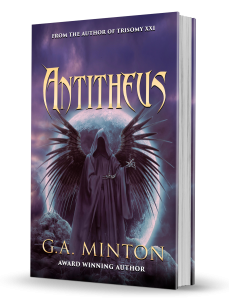Guest Post: Author G.A. Minton on Writing Horror
 Today, we’re hosting a guest post from author G.A. Minton, whose newest book, Antitheus, is out today!
Today, we’re hosting a guest post from author G.A. Minton, whose newest book, Antitheus, is out today!
~
Writing Horror
By G.A. Minton
Horror is defined as a feeling of great shock, fear, and worry caused by something extremely unpleasant; an intense feeling of fear, shock, or disgust. Edgar Allan Poe is not only recognized as the “Father of the Detective Story,” with his publication in Graham’s Magazine of The Murders In The Rue Morgue in 1841, but he is also the first American writer to popularize horror and the macabre. Poe is also credited with contributing to the emerging genre of science fiction.
Horror is a genre of fiction which has the capacity to frighten, scare, disgust, or startle its readers or viewers by inducing feelings of horror and terror. Howard Phillips (H.P.) Lovecraft, the master of the horror tale in the twentieth century, once said that “The oldest and strongest emotion of mankind is fear, and the oldest and strongest kind of fear is fear of the unknown.”
The components of a good horror story usually include fear, surprise, suspense, mystery, foreshadowing, and imagination. A good storyline will interconnect these important elements together in one way or another.
Fear is paramount to any horror story. Scaring the reader with fears they may or may not have (fear of the unknown) is key to writing a spooky tale. A strong emotion of fear sets horror apart from the other genres, and expanding on that fear can contribute to surprise. If the author can’t elicit fear in the reader, then the story shouldn’t fall into the horror genre.
Surprise is important in order to connect with the reader. If the writer can make the fear(s) a surprise, then the story will be even more exciting. Many horror movies rely on the element of surprise to terrify its audience. By tying a surprise to the end of a long suspense, the reader will stay hooked on the storyline.
Suspense can be used to keep the reader’s adrenaline flowing, especially if it plays off of fear. If the story is written well, then the reader will be afraid if the character is afraid. Well-placed suspense holds the reader’s interest in the story and puts them on the edge of their seat. If suspense is intertwined with fear, then it will keep the reader on a roller coaster ride. A suspenseful story is more often than not dependent on a good mystery.
Mystery is a strong element in any horror tale. Generally speaking, the more unknowns the author has in a story, the better the read. A mystery that’s not solved until the end of the book can definitely make for a suspenseful tale. Mystery and suspense can also be used together as a hook to keep the reader’s attention. In order to surprise its reader, a story needs a convincing mystery.
What’s the difference between mystery and suspense? Mystery contains one or more elements that remain unexplained or unknown until a story’s ending. A good mystery story showcases a given character’s struggle with different psychological and/or physical obstacles in an effort to achieve a particular goal or goals. Suspense is elicited when the reader isn’t aware of what’s coming next or what the outcome of an event or conflict in a story will be. A savvy author will create suspense by keeping the reader guessing as to what will happen next. As the great Alfred Hitchcock once said, “Suspense is the state of waiting for something to happen.” A mystery story reveals the major crime or event, followed by the protagonist solving the mystery of the who, why, and how of it. A suspense story delivers twists and turns before showing the crime or event later, thus eliciting a feeling of suspense in the reader. The enemy of suspense is predictability, which should be avoided when constructing the plot. Many authors are able to create a blend of suspense and mystery in their stories, thus providing a reliable way to keep their reader’s interest.
Foreshadowing is a way of preparing the reader for the climax of the story. By leaving well-placed clues in the plot and not giving away any answers, the author can make the mystery in his book even more enticing. Foreshadowing can be used as a tie-in to a mystery as it builds anticipation in the reader. An indication for the occurrence of future events, foreshadowing is a valuable tool for any writer.
Imagination can be a horror author’s best friend when used to construct the events, characters, situations, and storyline of a book. The reader can also draw upon their imagination as they conjure up images and visions of what they’ve read. When used synergistically, fear, mystery, and imagination are crucial to any good horror story. If the reader can imagine themselves as a character in a story, then the author has succeeded in his endeavors. “Description begins in the writer’s imagination, but should finish in the reader’s.” – Stephen King, On Writing: A Memoir of the Craft.
Why is it important to include mystery in a horror novel? Most people enjoy mysteries because it’s an intellectual challenge for them to figure out the answer to a puzzle. If the narrative contains a thought-provoking mystery, then the reader will want to know how the plot is resolved. A good mystery will leave clues that should keep the reader hanging until the end of the story. Horror is tailored for those readers who wish to have their imaginations stimulated through fear, especially psychological fear or fear of the unknown. Given that the human imagination knows no limits, a cornucopia of scary characters have been created throughout time, including monsters, demons, and ghosts, just to mention a few. The genres of horror, science fiction, and fantasy are usually based on fear and imagination, which is why they often overlap each other. A well-written horror novel can uncover a reader’s hidden anxiety or deepest nightmare—the more mysterious the antagonist, the more effective the horror. Adding mystery to horror not only makes for a more interesting story, but it also heightens the fear. Horror authors know that keeping the narrative terrifying is a must for any tale of horror. A horror story without mystery is like a body without a soul.
~
G.A. Minton Biography
 G.A. Minton has always been a diehard fan of science fiction and horror. Strangely enough, it was only after G.A. was rear-ended by a drunk driver and suffered a closed-head injury that he developed a newfound passion for writing. After numerous visits to a neurologist and months of taking medication used by patients afflicted with Alzheimer’s Disease, his injured brain slowly began to mend itself. When the damage to his brain finally healed, G.A. noticed something very different in his thought patterns. Now, there was an overwhelming urge, a compulsive drive to put on paper fascinating stories that had formed de novo in his mind. That’s how Trisomy XXI, his first novel and recipient of multiple awards, was born. One could surmise that the damaged neurons in G.A.’s frontal cortex had rearranged themselves into a different pattern, thereby enhancing the creative elements in his brain (a rare medical condition called “acquired savant syndrome”). G.A. is now referred to as “the savant horror writer” by his friends. Currently, his brain is busy at work, meticulously processing the text for another story of the macabre that will both entertain and horrify its reader. One of G.A.’s trademarks is that his stories contain an O. Henry or Rod Serling surprise ending that would baffle even the likes of the great Sherlock Holmes! G.A. lives in Texas with his wife, a son and daughter, and two Bengal cats named Phinneas and Shamus.
G.A. Minton has always been a diehard fan of science fiction and horror. Strangely enough, it was only after G.A. was rear-ended by a drunk driver and suffered a closed-head injury that he developed a newfound passion for writing. After numerous visits to a neurologist and months of taking medication used by patients afflicted with Alzheimer’s Disease, his injured brain slowly began to mend itself. When the damage to his brain finally healed, G.A. noticed something very different in his thought patterns. Now, there was an overwhelming urge, a compulsive drive to put on paper fascinating stories that had formed de novo in his mind. That’s how Trisomy XXI, his first novel and recipient of multiple awards, was born. One could surmise that the damaged neurons in G.A.’s frontal cortex had rearranged themselves into a different pattern, thereby enhancing the creative elements in his brain (a rare medical condition called “acquired savant syndrome”). G.A. is now referred to as “the savant horror writer” by his friends. Currently, his brain is busy at work, meticulously processing the text for another story of the macabre that will both entertain and horrify its reader. One of G.A.’s trademarks is that his stories contain an O. Henry or Rod Serling surprise ending that would baffle even the likes of the great Sherlock Holmes! G.A. lives in Texas with his wife, a son and daughter, and two Bengal cats named Phinneas and Shamus.
You can find out more information about G.A. Minton and his books at:
G.A. Minton Author Website: http://www.gaminton.com
G.A. Minton Author Webpage at World Castle Publishing Website: http://www.worldcastlepublishing.com/author_g_a_minton.html
Antitheus by G.A. Minton: www.amzn.com/B0744XJ11K
Trisomy XXI by G.A. Minton: www.amzn.com/1629894443

Comments